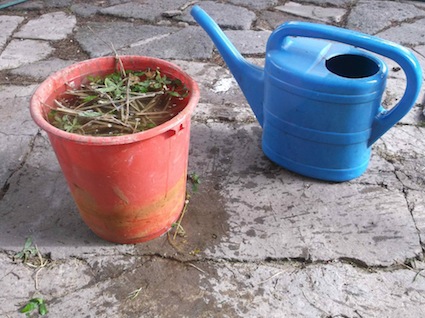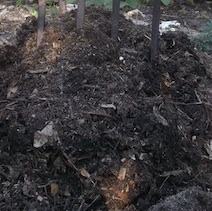Dear Reader, in this age of AI created content, please support with your goodwill someone who works harder to provide the human-made. Sign up at the top of the lefthand column or bottom of this page. You will receive my hand illustrated monthly newsletter RESTORE NATURE and access to the biodiversity garden design course as I write...and nothing else, I respect your time. I am also removing the advertizing as best I can as its become intrusive inappropriate and pays me nothing.
making garden fertilizer
some traditional anaerobic methods
The following section describes the easiest ways to make fertilizer using anaerobic decomposition. This type of compost "thrives on neglect". These broad categories approximately describe most home grown anaerobic composting methods:
making garden fertilizer using anaerobic processes
Closed or sealed method: Use a sealed plastic container (bag or bucket/box): put your organic waste in it and leave for a year, totally sealed.
Do not take a peep. I've read on the web about this method but have not tried it with kitchen waste.
Semi sealed: (sand or water covering) dig a trench, fill with organic waste and cover with soil. The trench of buried organics (newspaper, kitchen waste, branches, even old tins and more) to make garden fertilizer has been applied with great success by Abalimi Bezekhaya, a Catholic Welfare NGO that teaches gardening to previously unemployed women who live on top of the deep sand found in most of Cape Town . The Cape Flats, or greater Cape Town was once under a shallow sea, and is basically dune land with small seasonal marshes. My soil in Goodwood belongs to this system and I've also tried the trench method with success.
or: Make a perforated bucket, embed it in soil, fill it with organic waste and put a lid on it.
A partially anaerobic method of composting that thrives without the digging over needed for a hot heap, is to saturate a normal compost pile with water and cover it with a waterproof sheet. If it gets slimy and smelly this is good, say my sources.
For water immersion: put the organic material in a bucket of water. According to my source on the web, leave it for a year. Oxygen will enter the water in this method, so there will be some aerobic processing taking place at the same time as the anaerobic. The deeper the water, and less disturbed, the less this will be.
A traditional immersion method was used in the rice paddies of China for millennia. A trench near the paddy
would be filled with organic waste including green manure, old rice straw and animal manure, mixed with sediment (probably inoculates the material) covered with water, and a year later, when liquified, distributed over the rice fields. While a farming rather than garden fertilizer, if this method of recycling in situ on the same land worked for centuries to keep soil fertile, similar principles can apply in your garden.
a little more on the airless, or anaerobic process
Most of the home grown anaerobic processes for making garden fertilizer fit into these categories, so adapt them to your own needs and circumstances. To create a truly anaerobic environment, one should never open the vessel. Be aware that during maturation, methane will be produced and released into the atmosphere and you will be liberating one of the most potent greenhouse gases. A more nitrogen rich compost can be produced with anaerobic composting, and pathogens will not necessarily be wiped out by heat, as in the aerobic process of hot composting, but they will be hugely reduced by competition with more beneficial organisms.
The processes described above are rarely purely anaerobic or aerobic, because oxygen will leak into the containers, and there is dissolved oxygen in water. However if any aerobic activity occurs it will quickly deplete this oxygen, making oxygen a very scarce resource in the circumstances. However, intentionally mixed aerobic / anaerobic composting can also be used, and I'll describe this on another page.
high nitrogen composting
Sometimes I throw out the rule book on C : N ratios and just do my own thing. I steep dry brown garden waste in urine.
Fill a bucket with finely shredded material. I use sweepings of the tiny leaves from under my acacia tree. Top up slowly to the bucket edge with urine. My source is undisclosed but essentially animal like all other types. Let it stand for a week. An intense anaerobic brewing would have started. Then empty the bucket on the unplanted soil in a bed being prepared for heavy feeders. The horrendously smelly mush will stop smelling within a few hours and shrink down to fine black compost in record time. I still need to work out when it can be safely planted, and what environmental impact it would have if widely applied.
My understanding of anaerobic composting science gained from reading, will follow and an article on commercial anaerobic processing. A full description of how to use a mixed anaerobic - aerobic process on garden weeds to make "Jauche" or liquid green fertilizer is described here.
------
home page for green ideas and issues
------
------
vegetable gardening the natural low cost way
------
green fertilizer made from weeds and water
------
anaerobic composting introduction
------
------
a starter reference for anaerobic processes
Restore Nature Newsletter
I've been writing for four years now and I would love to hear from you
Please let me know if you have any questions, comments or stories to share on gardening, permaculture, regenerative agriculture, food forests, natural gardening, do nothing gardening, observations about pests and diseases, foraging, dealing with and using weeds constructively, composting and going offgrid.
SEARCH
Order the Kindle E-book for the SPECIAL PRICE of only
Prices valid till 30.09.2023
Recent Articles
-
garden for life is a blog about saving the earth one garden at a time
Apr 18, 25 01:18 PM
The garden for life blog has short articles on gardening for biodiversity with native plants and regenerating soil for climate amelioration and nutritious food -
Cape Flats Sand Fynbos, Cape Town's most endangered native vegetation!
Apr 18, 25 10:36 AM
Cape Flats Sand Fynbos, a vegetation type found in the super diverse Cape Fynbos region is threatened by Cape Town's urban development and invasive alien plants -
Geography Research Task
Jan 31, 25 11:37 PM
To whom it may concern My name is Tanyaradzwa Madziwa and I am a matric student at Springfield Convent School. As part of our geography syllabus for this
"How to start a profitable worm business on a shoestring budget
Order a printed copy from "Amazon" at the SPECIAL PRICE of only
or a digital version from the "Kindle" store at the SPECIAL PRICE of only
Prices valid till 30.09.2023









